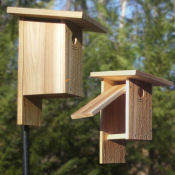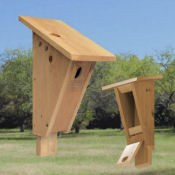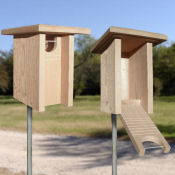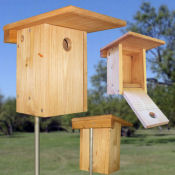

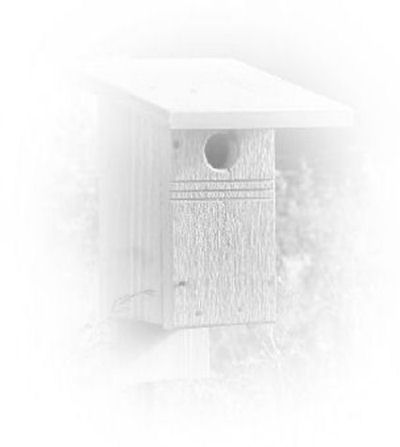
Whether you build your nestboxes, have them built or buy them, the ideal nestbox should have the following features:
Weather resistant design and construction
Adequate roof overhangs are critical for protection against rain and to provide cooling shade in hot weather. Joints should be tight and held together with exterior screws or the proper type nails (ring shank, spiral or coated). Brad nails and staples fail quickly and should not be used as the primary fasteners in a nestbox.
Access panel
The nestbox must have a panel that opens. This allows periodic inspections of the box interior (monitoring), and makes it easier to clean the box at the end of a nesting cycle. Whether the box opens from the side or front is a personal preference that you will develop over time. And once you do form an opinion on this detail, you can join the "lively" discussions on the merits of one over the other.
Made of durable and safe materials
A quality wood box is commonly made of 3/4" to 7/8" thick western red cedar or varieties of pine. Lumber thickness is vital for construction strength. Many of the mass produced, imported boxes available at discount stores and home and garden centers are made of thin wood - 1/2" in some cases - which lacks the strength to hold screws or nails. Avoid treated lumber at all costs, and never use OSB (oriented strand board), mdf (medium density fiberboard) or any type of particle board.
Adequate ventilation for your climate
A nestbox must have ventilation to purge itself of accumulating hot air. Cross ventilation, located just beneath the roof, is best. A general rule of thumb on side ventilation area is 2 to 3 square inches for cool climates and 4 to 6 square inches for hot climates. Keep in mind that temperature extremes can and do occur in most regions of North America during the nesting season, and it's much easier to close or block vents than it is to create them on an existing box.
Boxes with large entries - such as those found on slot boxes and on the Gilwood - commonly do not have side ventilation. While these large entries may provide enough ventilation for cool and moderate climates, in hotter climates adding side ventilation is advised.
Box properly sized for species
As a general rule, a floor size between 15 and 25 square inches is adequate for most small cavity nesters, although smaller and larger floors are successfully used for some species. The distance from the bottom of the entry to the floor can range from 4 1/2" to 7 1/2". The entry size is critical. 1-1/2" and 1-9/16" diameter holes will exclude starlings. Other entries, such as the Peterson oval and the Gilwood style will admit starlings, but are usually paired with smaller cavity boxes, which are less attractive to starlings. Slot entries of 1 3/16" height will exclude European Starlings but not House Sparrows.
No perch
Cavity-nesting birds evolved special feet to cling to vertical surfaces. A perch is therefore unnecessary and actually cramps their style. In addition, perches provide an unfair advantage to marauding House Sparrows and Starlings, who will use the perch both to block the entry and to defend a nestbox against desirable species.
Other design considerations
The nestbox roof can be pitched, flat or gabled. Entry doors can be bottom pivot (opening from the top down) or top pivot (opening from the bottom up). Advantages of each of these design aspects can be argued interminably, but it really boils down to personal preferences.
Slot boxes
Nestboxes with a horizontal slot rather than a conventional round or oval entry were designed to be less attractive to House Sparrows. These boxes are usually very shallow and have a small nest cavity. In some areas House Sparrows do not favor this combination, while in other regions slot boxes have no effect in deterring them.
PVC boxes
The most sparrow resistant box now available is the Gilbertson PVC. The small cavity - 12.5 square inch floor - is generally believed to be the factor.
Bluebird society recommendations
A great resource in helping you select the right nestbox for your area is the recommendation from your state's Bluebird society. If your state does not have one, check with states adjoining yours. A list of affiliated Bluebird societies can be found at the North American Bluebird Society.
Where to buy nestboxes
Boxes are available from the North American Bluebird Society and from many of their affiliated societies. Wild bird retail stores carry boxes, some suitable and some not. The imported nestboxes usually offered at at discount chains and home and garden centers should be avoided. These boxes are mass produced, made of thin wood and usually precariously held together with staples or brad nails.
Weather resistant design and construction
Adequate roof overhangs are critical for protection against rain and to provide cooling shade in hot weather. Joints should be tight and held together with exterior screws or the proper type nails (ring shank, spiral or coated). Brad nails and staples fail quickly and should not be used as the primary fasteners in a nestbox.
Access panel
The nestbox must have a panel that opens. This allows periodic inspections of the box interior (monitoring), and makes it easier to clean the box at the end of a nesting cycle. Whether the box opens from the side or front is a personal preference that you will develop over time. And once you do form an opinion on this detail, you can join the "lively" discussions on the merits of one over the other.
Made of durable and safe materials
A quality wood box is commonly made of 3/4" to 7/8" thick western red cedar or varieties of pine. Lumber thickness is vital for construction strength. Many of the mass produced, imported boxes available at discount stores and home and garden centers are made of thin wood - 1/2" in some cases - which lacks the strength to hold screws or nails. Avoid treated lumber at all costs, and never use OSB (oriented strand board), mdf (medium density fiberboard) or any type of particle board.
Adequate ventilation for your climate
A nestbox must have ventilation to purge itself of accumulating hot air. Cross ventilation, located just beneath the roof, is best. A general rule of thumb on side ventilation area is 2 to 3 square inches for cool climates and 4 to 6 square inches for hot climates. Keep in mind that temperature extremes can and do occur in most regions of North America during the nesting season, and it's much easier to close or block vents than it is to create them on an existing box.
Boxes with large entries - such as those found on slot boxes and on the Gilwood - commonly do not have side ventilation. While these large entries may provide enough ventilation for cool and moderate climates, in hotter climates adding side ventilation is advised.
Box properly sized for species
As a general rule, a floor size between 15 and 25 square inches is adequate for most small cavity nesters, although smaller and larger floors are successfully used for some species. The distance from the bottom of the entry to the floor can range from 4 1/2" to 7 1/2". The entry size is critical. 1-1/2" and 1-9/16" diameter holes will exclude starlings. Other entries, such as the Peterson oval and the Gilwood style will admit starlings, but are usually paired with smaller cavity boxes, which are less attractive to starlings. Slot entries of 1 3/16" height will exclude European Starlings but not House Sparrows.
No perch
Cavity-nesting birds evolved special feet to cling to vertical surfaces. A perch is therefore unnecessary and actually cramps their style. In addition, perches provide an unfair advantage to marauding House Sparrows and Starlings, who will use the perch both to block the entry and to defend a nestbox against desirable species.
Other design considerations
The nestbox roof can be pitched, flat or gabled. Entry doors can be bottom pivot (opening from the top down) or top pivot (opening from the bottom up). Advantages of each of these design aspects can be argued interminably, but it really boils down to personal preferences.
Slot boxes
Nestboxes with a horizontal slot rather than a conventional round or oval entry were designed to be less attractive to House Sparrows. These boxes are usually very shallow and have a small nest cavity. In some areas House Sparrows do not favor this combination, while in other regions slot boxes have no effect in deterring them.
PVC boxes
The most sparrow resistant box now available is the Gilbertson PVC. The small cavity - 12.5 square inch floor - is generally believed to be the factor.
Bluebird society recommendations
A great resource in helping you select the right nestbox for your area is the recommendation from your state's Bluebird society. If your state does not have one, check with states adjoining yours. A list of affiliated Bluebird societies can be found at the North American Bluebird Society.
Where to buy nestboxes
Boxes are available from the North American Bluebird Society and from many of their affiliated societies. Wild bird retail stores carry boxes, some suitable and some not. The imported nestboxes usually offered at at discount chains and home and garden centers should be avoided. These boxes are mass produced, made of thin wood and usually precariously held together with staples or brad nails.
The search for the perfect nestbox seems an elusive goal. No single box design works for everyone, nor does it work in every region or circumstance. The perfect nestbox does exist, but it's not the design itself that makes it so.
A successful nestbox is one element in an overall system, which includes its mount, the location within good habitat and adequate predator controls.
Combine those factors with the most important element of all - you, and your committment to actively managing the entire system - and you are very close to having the perfect nestbox.
A successful nestbox is one element in an overall system, which includes its mount, the location within good habitat and adequate predator controls.
Combine those factors with the most important element of all - you, and your committment to actively managing the entire system - and you are very close to having the perfect nestbox.
The Xbox is a front opening nestbox with a bottom pivoting door. An inner roof provides a second level of protection if the main roof warps or splits.
The GIlbertson PVC was designed by Steve GIlbertson. Made from 4" diameter thinwall PVC. The "tube" detaches from the roof for monitoring.
With its steeply pitched roof, angled front and unique oval entry, the Peterson has become an iconic legend.
(Designed by Dick Peterson)
(Designed by Dick Peterson)
Some popular nestbox designs
(click on image to enlarge)
The "NABS" box, currently the flagship box of the North American Bluebird Society, is a side opening nestbox with a pitched roof.
The GIlwood by Steve Gilbertson has a large, inverted "mouse hole" entry. A wire reduces the functional size of the entry while still allowing airflow.
To download plans for the above boxes, or to view more nestboxes, please visit our Plans page.
Selecting the Right Nestbox

Home | Site Map | Disclaimer | Contact Us
Copyright © 2012 NestboxBuilder.com
This site was last updated on 01/01/2016
Copyright © 2012 NestboxBuilder.com
This site was last updated on 01/01/2016
